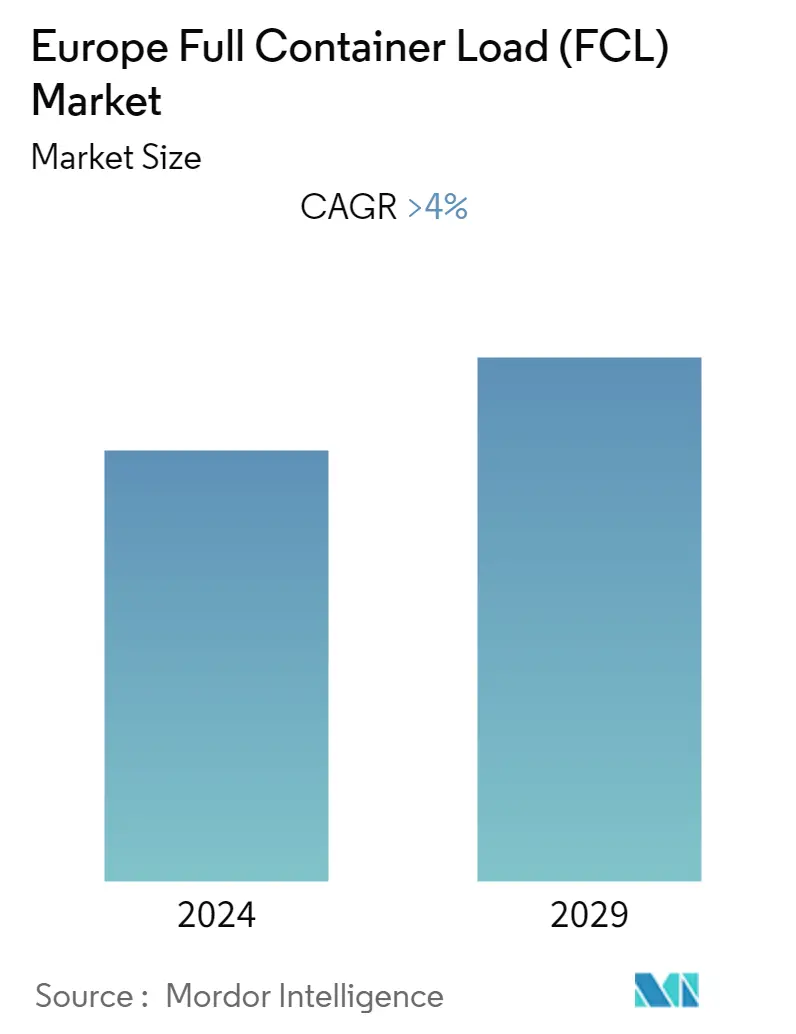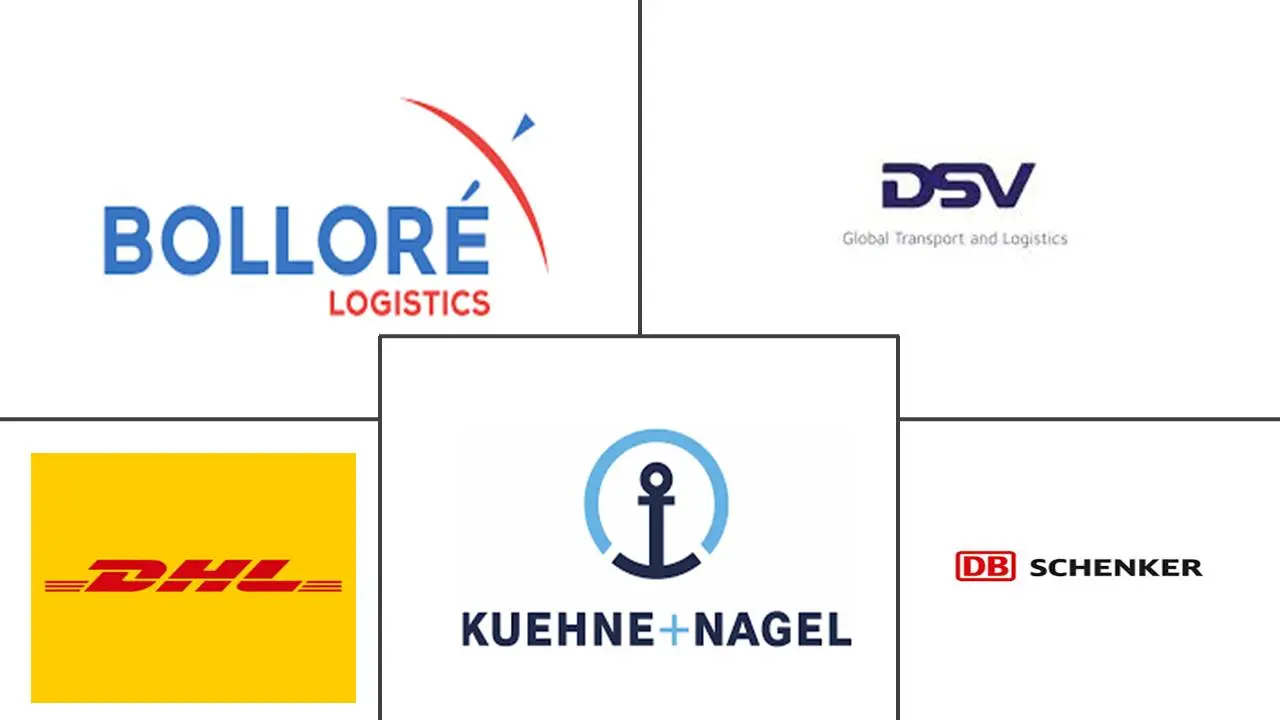Market Size of Europe Full Container Load (FCL) Industry

| Study Period | 2020 - 2029 |
| Base Year For Estimation | 2023 |
| CAGR | 4.00 % |
| Fastest Growing Market | Asia-Pacific |
| Largest Market | North America |
| Market Concentration | Low |
Major Players
*Disclaimer: Major Players sorted in no particular order |
Europe Full Container Load (FCL) Market Analysis
Europe full container load market is expected to grow at a CAGR of more than 4% during the forecast period of 2022-2027.
The COVID-19 crisis fundamentally disrupted the demand and supply in the European Full Container Load (FCL) market. Following years of pandemic-related losses, Europe's major North Range ports saw gains in cargo and container throughput in 2021, putting them back on track to reach pre-pandemic levels in 2019.
Digitization has been more prominent in the transportation business in recent years. Economic growth, population increase, and industrialization growth are all key drivers of market expansion. Antwerp, Rotterdam, Hamburg, Piraeus, and Bremerhaven are some of the biggest and busiest of Europe's 20 major marine ports that can handle container loads. The worldwide freight forwarders network's member companies may provide you with forwarding services to all of Europe's major sea ports, as well as loading separate containers for FCL shipments or merging your cargo with that of other customers for LCL shipments. 40% market growth is contributed by Europe in sea frieght forwarding market.
The advantages of FCL shipments include a speedier delivery time because the container does not need to be opened along the way. FCL sea freight, rail freight, and truck freight are all transported in distinct ways. Even still, shipping by ship is the most popular mode.
Europe Full Container Load (FCL) Industry Segmentation
Full Container Load (FCL) shipping is a way of transporting goods that is commonly utilised by customers who need to transfer large, bulky items or have a huge volume of goods that can fill an entire container.
Europe Full Container Load Market is segmented By Service (Transport, Freight Forwarding and Other Services (Includes Value-added Services such as Documentation, Customs Clearance, etc.), By End-user (Automotive,Chemicals, FMCG (Fast-moving Consumer Goods), Retail (Hypermarket, Supermarket, Convebience Stores, and e-commerce), Fashion & Lifestyle (Apparel and Footwear), Reefer (Fruits, Vegetables, Pharma, Meat, Fish, Seafoods), Technology (Consumer Electronics, Home Appliances) and Other End-users) and by Country (Germany, United Kingdom, France, Russia,Rest of Europe).
The report also covers the impact of COVID-19 on the market. The report offers market size and forecasts for the Europe Full Container Load (FCL) market in value (USD billion) for all the above segments.
| By Service | |
| Transport | |
| Freight Forwarding and Other Services(Includes Value-added Services such as Documentation, Customs Clearance, etc.) |
| By End-user | |
| Automotive | |
| Chemicals | |
| FMCG(Fast-moving Consumer Goods) | |
| Retail(Hypermarket, Supermarket, Convebience Stores, and e-commerce) | |
| Fashion & Lifestyle(Apparel and Footwear) | |
| Reefer (Fruits, Vegetables, Pharma, Meat, Fish, Seafoods) | |
| Technology(Consumer Electronics, Home Appliances) | |
| Other End-users |
| Country | |
| Germany | |
| United Kingdom | |
| France | |
| Russia | |
| Rest of Europe |
Europe Full Container Load (FCL) Market Size Summary
The European Full Container Load (FCL) market is poised for growth, driven by factors such as economic expansion, population growth, and industrialization. The market experienced disruptions due to the COVID-19 pandemic, but major ports like Antwerp, Rotterdam, and Hamburg have rebounded, regaining cargo and container throughput levels. The integration of digitization in transportation has become increasingly significant, enhancing efficiency and service delivery. The FCL shipments offer advantages like faster delivery times, as containers remain sealed during transit. While sea freight remains the dominant mode of transport, rail freight is gaining importance as a strategic link between Europe and Asia, with improvements in railway logistics and infrastructure supporting this growth. The consumer electronics sector is expected to further boost rail cargo demand, with manufacturers relying on rail services for timely deliveries.
The European FCL market is characterized by a mix of global and regional players, with companies like Kuehne + Nagel International AG, DHL, and DB Schenker leading the charge. The market's growth is supported by advancements in technology and e-commerce, with logistics companies adopting innovative solutions to enhance their offerings. Initiatives by governmental bodies and collaborations between European and African Digital Innovation Hubs are fostering smart logistics solutions, ensuring the market's long-term viability. The Port of Rotterdam, the largest container port in the EU, benefits from its extensive rail connections, while the Port of Antwerp continues to be a key player despite challenges. The market's fragmented nature presents opportunities for growth, with sustainability and digital innovation playing crucial roles in shaping the future landscape.
Europe Full Container Load (FCL) Market Size - Table of Contents
-
1. MARKET INSIGHTS
-
1.1 Current Market Scenario
-
1.2 Value Chain/Supply Chain Analysis
-
1.3 Government Regulations and Initiatives
-
1.4 Technology Innovation and its Impact
-
1.5 Insights into the E-commerce Industry in the Region (both Domestic and Cross-border)
-
1.6 Spotlight - FCL Transportation Costs/Freight Rates
-
1.7 Impact of COVID-19 on the Market
-
-
2. MARKET SEGMENTATION
-
2.1 By Service
-
2.1.1 Transport
-
2.1.2 Freight Forwarding and Other Services(Includes Value-added Services such as Documentation, Customs Clearance, etc.)
-
-
2.2 By End-user
-
2.2.1 Automotive
-
2.2.2 Chemicals
-
2.2.3 FMCG(Fast-moving Consumer Goods)
-
2.2.4 Retail(Hypermarket, Supermarket, Convebience Stores, and e-commerce)
-
2.2.5 Fashion & Lifestyle(Apparel and Footwear)
-
2.2.6 Reefer (Fruits, Vegetables, Pharma, Meat, Fish, Seafoods)
-
2.2.7 Technology(Consumer Electronics, Home Appliances)
-
2.2.8 Other End-users
-
-
2.3 Country
-
2.3.1 Germany
-
2.3.2 United Kingdom
-
2.3.3 France
-
2.3.4 Russia
-
2.3.5 Rest of Europe
-
-
Europe Full Container Load (FCL) Market Size FAQs
What is the current Europe Full Container Load (FCL) Market size?
The Europe Full Container Load (FCL) Market is projected to register a CAGR of greater than 4% during the forecast period (2024-2029)
Who are the key players in Europe Full Container Load (FCL) Market?
Kuehne + Nagel International AG , DHL, DB Schenker , DSV Global and Bolloré Logistics are the major companies operating in the Europe Full Container Load (FCL) Market.

